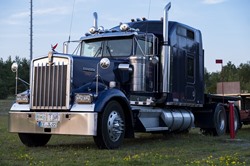How to Decide on the Best CDL Driving Classes near Strasburg North Dakota
 Congrats on your decision to become a trucker and enroll in a CDL school near Strasburg ND. Perhaps it has always been your dream to hit the open highway while driving a huge tractor trailer. Or possibly you have conducted some research and have found that an occupation as a truck driver offers excellent pay and flexible work opportunities. Whatever your reason is, it’s important to obtain the appropriate training by picking the right CDL school in your area. When evaluating your options, there are various factors that you’ll want to examine before making your final selection. Location will certainly be important, particularly if you have to commute from your Strasburg residence. The expense will also be of importance, but choosing a school based entirely on price is not the optimal method to guarantee you’ll obtain the proper training. Don’t forget, your objective is to learn the knowledge and skills that will enable you to pass the CDL examinations and become a qualified truck driver. So keeping that objective in mind, just how do you decide on a truck driving school? That is what we are going to discuss in the balance of this article. But first, we are going to discuss a little bit about which CDL license you will eventually need.
Congrats on your decision to become a trucker and enroll in a CDL school near Strasburg ND. Perhaps it has always been your dream to hit the open highway while driving a huge tractor trailer. Or possibly you have conducted some research and have found that an occupation as a truck driver offers excellent pay and flexible work opportunities. Whatever your reason is, it’s important to obtain the appropriate training by picking the right CDL school in your area. When evaluating your options, there are various factors that you’ll want to examine before making your final selection. Location will certainly be important, particularly if you have to commute from your Strasburg residence. The expense will also be of importance, but choosing a school based entirely on price is not the optimal method to guarantee you’ll obtain the proper training. Don’t forget, your objective is to learn the knowledge and skills that will enable you to pass the CDL examinations and become a qualified truck driver. So keeping that objective in mind, just how do you decide on a truck driving school? That is what we are going to discuss in the balance of this article. But first, we are going to discuss a little bit about which CDL license you will eventually need.
Which CDL Will You Require?
 In order to drive commercial vehicles lawfully within the United States and Strasburg ND, an operator must attain a CDL (Commercial Driver’s License). The three classes of licenses that a driver can qualify for are Class A, Class B and Class C. Since the topic of this article is how to choose a truck driving school, we will focus on Class A and Class B licenses. What differentiates each class of CDL is the kind of vehicle that the driver can operate in addition to the GVWR (Gross Vehicle Weight Rating) or GCWR (Gross Combination Weight Rating). Below are brief summaries for the two classes.
In order to drive commercial vehicles lawfully within the United States and Strasburg ND, an operator must attain a CDL (Commercial Driver’s License). The three classes of licenses that a driver can qualify for are Class A, Class B and Class C. Since the topic of this article is how to choose a truck driving school, we will focus on Class A and Class B licenses. What differentiates each class of CDL is the kind of vehicle that the driver can operate in addition to the GVWR (Gross Vehicle Weight Rating) or GCWR (Gross Combination Weight Rating). Below are brief summaries for the two classes.
Class A CDL. A Class A CDL is required to drive any vehicle that has a GCWR of greater than 26,000 lbs., including a towed vehicle of more than 10,000 lbs. Some of the vehicles that drivers may be able to operate with Class A licenses are:
- Interstate or Intrastate Tractor Trailers
- Trucks with Double or Triple Trailers
- Tanker Trucks
- Livestock Carriers
- Class B and Class C Vehicles
Class B CDL. A Class B CDL is needed to operate single vehicles having a GVWR of greater than 26,000 lbs., or a GCWR of more than 26,000 lbs. including a towed vehicle weighing up to 10,000 lbs. A few of the vehicles that drivers may be qualified to operate with Class B licenses are:
- Tractor Trailers
- Dump Trucks
- Cement Mixers
- Large Buses
- Class C Vehicles
Both Class A and Class B CDLs may also require endorsements to drive specific types of vehicles, for instance passenger or school buses. And a Class A licensee, with the proper required endorsements, can drive any vehicle that a Class B license holder is authorized to drive.
Click Here to Get Free Information on Truck Driving Schools Near You!
How to Evaluate a Truck Driver School
 As soon as you have determined which CDL you would like to pursue, you can begin the process of assessing the Strasburg ND truck driving schools that you are looking at. As previously discussed, cost and location will certainly be your primary considerations. But it can’t be stressed enough that they should not be your sole considerations. Other variables, such as the reputations of the schools or the experience of the instructors are similarly if not more important. So below are several more things that you need to research while conducting your due diligence before selecting, and particularly paying for, your truck driver training.
As soon as you have determined which CDL you would like to pursue, you can begin the process of assessing the Strasburg ND truck driving schools that you are looking at. As previously discussed, cost and location will certainly be your primary considerations. But it can’t be stressed enough that they should not be your sole considerations. Other variables, such as the reputations of the schools or the experience of the instructors are similarly if not more important. So below are several more things that you need to research while conducting your due diligence before selecting, and particularly paying for, your truck driver training.
Are the Schools Certified or Accredited ? Not many truck driver schools in the Strasburg ND area are accredited due to the demanding process and expense to the schools. On the other hand, certification is more commonplace and is provided by the Professional Truck Driver Institute (PTDI). A school is not obligated to become certified, but there are a number of advantages. Interested students recognize that the training will be of the highest quality, and that they will be given lots of driving time. As an example, PTDI requires 44 hours of real driving time, not simulations or ride-alongs. So if a school’s program is certified (the program, not the school is certified), students know that the training and curriculum will meet the very high standards set by PTDI.
How Long in Business? One clue to help determine the quality of a truck driving school is how long it has been in operation. A negatively ranked or a fly by night school usually will not stay in business very long, so longevity is a plus. On the other hand, even the best of Strasburg ND schools had to begin from their opening day of training, so consider it as one of multiple qualifications. You can also learn what the school’s track record is relating to successful licensing and employment of its graduates. If a school won’t supply those numbers, search elsewhere. The schools should also have relationships with local and national trucking companies. Having numerous contacts not only affirms a quality reputation within the profession, but also boosts their job assistance program for students. It also wouldn’t be a bad idea to contact the North Dakota licensing department to verify that the CDL trucking schools you are reviewing are in good standing.
How Good is the Training? At a minimum, the schools must be licensed in North Dakota and employ instructors that are experienced and trained. We will talk more about the instructors in the next segment. Also, the student to instructor proportion should not be greater than 4 to 1. If it’s any higher, then students will not be receiving the personalized instruction they will need. This is especially true regarding the one-on-one instruction for behind the wheel training. And be critical of any school that insists it can train you to be a truck driver in a comparatively short time period. Learning to be an operator and to drive a tractor trailer professionally requires time. Most Strasburg ND schools offer training programs that run from 3 weeks to as long as 2 months, depending on the class of license or kind of vehicle.
How Experienced are the Instructors? As previously stated, it’s imperative that the teachers are trained to teach driving techniques and experienced as both drivers and instructors. Even though a number of states have minimum driving time requirements to qualify as a teacher, the more professional driving experience an instructor has the better. It’s also crucial that the teachers keep up to date with industry advancements or any new laws or changes in regulations. Evaluating teachers might be a bit more subjective than other standards, and perhaps the ideal method is to check out the school and talk to the teachers in person. You can also speak with a few of the students going through the training and find out if they are happy with the level of instruction and the teacher’s ability to train them.
Sufficient Driving Time? Most importantly, a great truck driver school will furnish ample driving time to its students. After all, isn’t that what it’s all about? Driving time is the actual time spent behind the wheel operating a truck. Even though the use of simulators and ride-a-longs with other students are essential training tools, they are no substitute for actual driving. The more training that a student receives behind the wheel, the better driver she or he will be. And even though driving time fluctuates between schools, a good benchmark is 32 hours at a minimum. If the school is PTDI certified, it will provide a minimum of 44 hours of driving time. Check with the Strasburg ND schools you are looking at and ask how much driving time they provide.
Are they Independent or Captive ? You can receive free or discounted training from some truck driver schools if you enter into an agreement to drive for a particular carrier for a defined amount of time. This is what’s known as contract training, and the schools that offer it are called captives. So rather than maintaining affiliations with numerous trucking lines that they can place their graduates with, captives only work with one company. The tradeoff is receiving less expensive or even free training by surrendering the freedom to initially work wherever you choose. Naturally contract training has the potential to reduce your income prospects when starting out. But for many it may be the ideal way to receive affordable training. Just be sure to find out if the Strasburg ND schools you are looking at are independent or captive so that you can make an informed decision.
Provide Onsite CDL Testing? There are several states that will permit third party CDL testing onsite of truck driving schools for its graduates. If onsite testing is permitted in North Dakota, find out if the schools you are reviewing are DMV certified to offer it. One advantage is that it is more accommodating than competing with graduates from competing schools for test times at North Dakota testing facilities. It is also an indicator that the DMV believes the authorized schools to be of a higher quality.
Are the Class Times Flexible? As formerly noted, truck driving training is just 1 to 2 months in length. With such a short duration, it’s imperative that the Strasburg ND school you select offers flexibility for both the scheduling of classes and the curriculum. As an example, if you’re having difficulty learning a certain driving maneuver, then the teacher should be willing to commit more time with you until you are proficient. And if you’re still employed while going to training, then the class scheduling must be flexible enough to fit in working hours or other obligations.
Is Job Placement Provided? The moment you have obtained your commercial driver’s license after graduating from truck driving school, you will be keen to begin your new profession. Verify that the schools you are looking at have job assistance programs. Ask what their job placement rate is and what average salary their grads start at. Also, find out which national and local trucking companies their graduates are referred to for employment. If a school has a lower job placement rate or few Strasburg ND employers recruiting their graduates, it may be a sign to look elsewhere.
Is Financial Aid Provided? Trucking schools are much like colleges and other Strasburg ND area vocational or trade schools when it comes to loans and other forms of financial aid being available. Ask if the schools you are assessing have a financial assistance department, or at least someone who can help you get through the options and forms that must be submitted.
CDL Training Near Me Strasburg North Dakota
 Picking the appropriate truck driver school is an important first step to starting your new occupation as a local or long distance truck driver. The skill sets taught at school will be those that forge a new career behind the wheel. There are several options offered and understanding them is vital to a new driver’s success. You originally came to our website because of your interest in CDL Training Near Me and wanting information on the topic Trucking School Cost. However, you must receive the proper training in order to drive a big commercial vehicle in a safe and professional manner. If you are short on funds or financing, you might want to look into a captive school. You will pay a lower or even no tuition in exchange for driving for their contracted carrier. Or you can enroll in an independent trucker school and have the the freedom to drive for the trucking company of your choice, or one of many affiliated with the school. It’s your choice. But no matter how you get your training, you will soon be joining a profession that helps our country move as a professional trucker in Strasburg ND.
Picking the appropriate truck driver school is an important first step to starting your new occupation as a local or long distance truck driver. The skill sets taught at school will be those that forge a new career behind the wheel. There are several options offered and understanding them is vital to a new driver’s success. You originally came to our website because of your interest in CDL Training Near Me and wanting information on the topic Trucking School Cost. However, you must receive the proper training in order to drive a big commercial vehicle in a safe and professional manner. If you are short on funds or financing, you might want to look into a captive school. You will pay a lower or even no tuition in exchange for driving for their contracted carrier. Or you can enroll in an independent trucker school and have the the freedom to drive for the trucking company of your choice, or one of many affiliated with the school. It’s your choice. But no matter how you get your training, you will soon be joining a profession that helps our country move as a professional trucker in Strasburg ND.
Truck On in These Other North Dakota Locations
Strasburg, North Dakota
Strasburg was laid out in 1902 when a spur of the Chicago, Milwaukee, St. Paul Railroad was extended to that point.[6] The city was named after Straßburg, Ukraine, then in South Russia and now named Kuchurhan, Rozdilna Raion. That place was, in turn, named for Strassburg in Alsace.[7] A post office has been in operation at Strasburg since 1903.[8]
Historic sites in or near Strasburg include Tirsbol Cemetery, Wrought-Iron Cross Site, Wrought-iron cross sites of Holy Trinity Cemetery (Strasburg, North Dakota), and Ludwig and Christina Welk Homestead.
As of the census[2] of 2010, there were 409 people, 191 households, and 95 families residing in the city. The population density was 1,363.3 inhabitants per square mile (526.4/km2). There were 224 housing units at an average density of 746.7 per square mile (288.3/km2). The racial makeup of the city was 99.8% White and 0.2% from two or more races. Hispanic or Latino of any race were 0.2% of the population.
